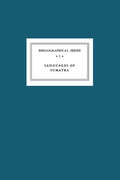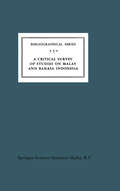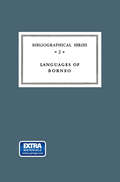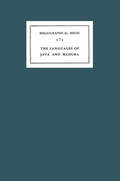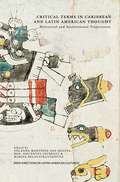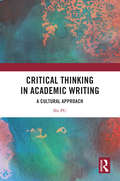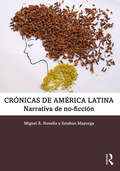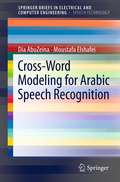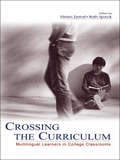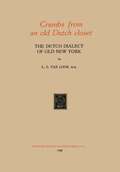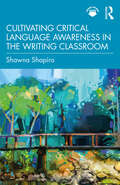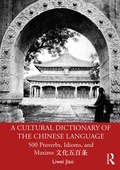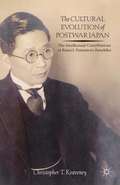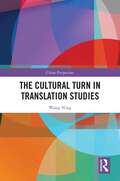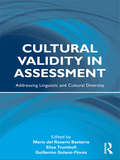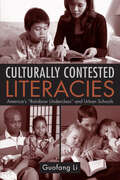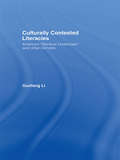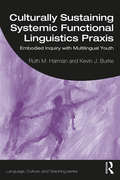- Table View
- List View
Critical Survey Of Studies On The Languages of Sumatra (Koninklijk Instituut voor Taal-, Land- en Volkenkunde)
by P. VoorhoeveThe aim of the critical bibliographies, compiled on the initiative of the Board of Directors of the Royal Institute of Linguistics, Geography and Ethnology, is to draw attention to the data on Indonesian lin~ guistics and cultural sciences collected in the past, and to provide guidance in this field. It so happens that these data were often published in journals with a limited circulation, whilst these journals are only available in a few places. Moreover, most of them are only accessible without difficulty to those workers in the fields of Indonesian linguistics and cultural sciences who possess some knowledge of the Dutch language. Apart from providing information, these bibliographies also have an other object, viz. to prevent that meritorious scholarly work would be lost due to the purely fortuitous circumstance - which, however, in actual practice is unfortunately of decisive importance - that this work is not written in a world language and that it cannot be every where easily consulted. The Board therefore hope at the same time to break with the slightly provincialistic nature which for evident reasons used to be characteristic for the studies in language and culture of Indonesia. The Board hope to be able to prevent that new research should have to start unnecessarily again at the very beginning, and also to contribute to a more rapid progress of scientific research in this field by means of a regular publication of these critical reviews of pubIications.
A Critical Survey of Studies on Malay and Bahasa Indonesia: Bibliographical Series 5 (Koninklijk Instituut voor Taal-, Land- en Volkenkunde #5)
by A. TeeuwIn this book I have aimed at completeness in the sense that all publications known to me, which are wholly or partly devoted to Malay and Bahasa Indonesia (B.I.), or are important for the study of these languages, have been included. Popular publications in non-professional periodicals have been included only exceptionally. All the publications mentioned in the text are incorporated in the Bibliography (p. 91-157). The countless articles in four post-war, semi-professional periodicals in :'1alaya and Indonesia, Dewan Bahasa, Pembina Bahasa Indonesia. 11:1 edan Bahasa, Bahasa dan Budaja, are not mentioned separately in the Bibliography, but sections 33 to 36 contain a survey, as complete and systematic as possible, of the contents of these periodicals in so far as they pertain to the Malay language; nor have I discussed in the text or incorporated in the Bibliography several hundreds of titles of practical textbooks or school-books of Malay or B.I. which are of no importance to the scientific study of these language. These titles have been entered in a separate Appendix (p. 158--171). The fact that completeness was aimed at certainly does not mean that it has been achieved. Especially various recent writings from Indonesia and Malaya may have escaped my attention. Experience has also proved that publications on Malay sometimes appear in the most unexpected places. The qualification above: "publications ... devoted to ... , or impor tant for the study of" Malay and B.I. has been taken in a wide sense.
Critical Survey of Studies on the Languages of Borneo (Koninklijk Instituut voor Taal-, Land- en Volkenkunde #2)
by Anton Abraham Cense E.M. UhlenbeckAt the completion of this bibliography, the second of the planned series on language study in Indonesia, the authors acknowledge with gratitude the kind assistance of Father Donatus Dunselman, Dr A. H. Hill and Dr P. Voorhoeve who have read all or part of the manuscript. Also our heartfelt thanks are due to those who have provided us with information indispensable for the compilation of the bibliographical data, or have given us the opportunity to inspect their archives for linguistic literature on Borneo, i.e. the very Rev. A. Antonissen, Jesselton, North Borneo, Father W. Boon, Rector of the Catholic Mission, Mukah, Sarawak, Dr N. C. Scott, the Society for promoting Christian Knowledge, London, the British and Foreign Bible Society, London, the School of Oriental and African Studies, London, the Basle Mission, Basle, Switzerland, the Rhenish Mission, Wuppertal, Germany, the Dutch Bible Society, Amsterdam. The authors greatly appreciate the grant from the Netherland Institute for International Cultural Relations which made this public ation possible.
A Critical Survey of Studies on the Languages of Java and Madura: Bibliographical Series 7 (Koninklijk Instituut voor Taal-, Land- en Volkenkunde #3)
by E.M. UhlenbeckAt the completion of this critical bibliography which forms another step in the direction of the realization of the bibliographical project inaugurated in 1955 by Dr. Voorhoeve's survey of the languages of Sumatra, I acknowledge with gratitude the valuable assistance received from various people. I am indebted to my colleagues Prof. Dr. G. W. J. Drewes, Dr. J. Noorduyn, Dr. Th. Pigeaud, Prof. Dr. A. Teeuw and Dr. P. Voorhoeve, who read all or part of the manuscript and who generously put their extensive knowledge of the Java languages at my disposal. Heartfelt thanks are due to Mr. B. J. Hoff and Mr. A. G. Sciarone, both members of my staff, who verified many of the biblio graphical details. I am grateful to the library of the University of Leiden and to the library of the Institute in The Hague because of their readiness in giving me all the facilities I needed for the preparation of this book. Most useful was the cordial assistance received from my colleague Prof. Dr. P. E. de Josselin de Jong, who spent much time correcting the many imperfections of my English text, which greatly promoted the readability of the narrative sections of this survey.
Critical Terms in Caribbean and Latin American Thought: Historical and Institutional Trajectories (New Directions in Latino American Cultures)
by Ben. Sifuentes-Jáuregui Yolanda Martínez-San Miguel Marisa BelausteguigoitiaThrough a collection of critical essays, this work explores twelve keywords central in Latin American and Caribbean Studies: indigenismo, Americanism, colonialism, criollismo, race, transculturation, modernity, nation, gender, sexuality, testimonio, and popular culture. The central question motivating this work is how to think—epistemologically and pedagogically—about Latin American and Caribbean Studies as fields that have had different historical and institutional trajectories across the Caribbean, Latin America, and the United States.
Critical Thinking in Academic Writing: A Cultural Approach
by Shi PuThe book inquires into critical thinking through a cultural approach. Based on an 8-month ethnographic study, it compares Chinese postgraduate students’ conceptualisations and applications of critical thinking in three different settings in China and the UK. From an insider’s perspective, it analyses the intricate interplay of multiple cultural and individual factors that conditions students’ critical thinking development as they learn to write an academic thesis and to manage postgraduate learning. The book offers insights into the nature of problems that Chinese students encounter with critical thinking and envisions possibilities for the ideas for critical thinking to have a transformative power in an intercultural space. The book will primarily be of interest to academics and educators who work on critical thinking and academic writing, especially those who work with Chinese students. Scholars interested in intercultural issues in higher education may also find it relevant.
Critical Thinking in Academic Writing: A Cultural Approach
by Shi PuThe book inquires into critical thinking through a cultural approach. Based on an 8-month ethnographic study, it compares Chinese postgraduate students’ conceptualisations and applications of critical thinking in three different settings in China and the UK. From an insider’s perspective, it analyses the intricate interplay of multiple cultural and individual factors that conditions students’ critical thinking development as they learn to write an academic thesis and to manage postgraduate learning. The book offers insights into the nature of problems that Chinese students encounter with critical thinking and envisions possibilities for the ideas for critical thinking to have a transformative power in an intercultural space. The book will primarily be of interest to academics and educators who work on critical thinking and academic writing, especially those who work with Chinese students. Scholars interested in intercultural issues in higher education may also find it relevant.
Crónicas de América Latina: narrativa de no-ficción
by Miguel Á. Novella Esteban MayorgaCrónicas de América Latina: narrativa de no-ficción es la primera edición de una novedosa antología de crónicas diseñada para la enseñanza de español avanzado. Los textos, fascinantes y accesibles, permiten que los estudiantes se adentren en la compleja realidad contemporánea, tanto política como social y cultural, de América Latina, mientras refuerzan la lectura, la redacción y la conversación. Los ejercicios, todos ellos diseñados a partir de los propios textos, pretenden repasar problemas gramaticales y léxicos tradicionales, con especial énfasis en aquellos que atañen a las variedades dialectales del español americano: por ejemplo, el uso del pronombre ‘vos’. Este libro es un excelente material de lectura que puede usarse en clases de español como segunda lengua o en clases de español para hablantes de herencia, tanto en clases de lengua (gramática o conversación) como de contenido (cultura). Dividido en nueve capítulos, el material abarca temas cruciales tales como política, identidad, raza, género, inmigración, violencia, exilio, medio ambiente, gastronomía, fútbol y música. Cada texto puede leerse de forma independiente, lo que permite que los profesores seleccionen las lecturas según las particularidades de cada curso. Pensado en un principio para estudiantes de español, esta antología es sobre todo una lectura indispensable para cualquier persona interesada en la zona que concentra el mayor número de hispanohablantes en el mundo.
Crónicas de América Latina: narrativa de no-ficción
by Miguel Á. Novella Esteban MayorgaCrónicas de América Latina: narrativa de no-ficción es la primera edición de una novedosa antología de crónicas diseñada para la enseñanza de español avanzado. Los textos, fascinantes y accesibles, permiten que los estudiantes se adentren en la compleja realidad contemporánea, tanto política como social y cultural, de América Latina, mientras refuerzan la lectura, la redacción y la conversación. Los ejercicios, todos ellos diseñados a partir de los propios textos, pretenden repasar problemas gramaticales y léxicos tradicionales, con especial énfasis en aquellos que atañen a las variedades dialectales del español americano: por ejemplo, el uso del pronombre ‘vos’. Este libro es un excelente material de lectura que puede usarse en clases de español como segunda lengua o en clases de español para hablantes de herencia, tanto en clases de lengua (gramática o conversación) como de contenido (cultura). Dividido en nueve capítulos, el material abarca temas cruciales tales como política, identidad, raza, género, inmigración, violencia, exilio, medio ambiente, gastronomía, fútbol y música. Cada texto puede leerse de forma independiente, lo que permite que los profesores seleccionen las lecturas según las particularidades de cada curso. Pensado en un principio para estudiantes de español, esta antología es sobre todo una lectura indispensable para cualquier persona interesada en la zona que concentra el mayor número de hispanohablantes en el mundo.
Cross-Word Modeling for Arabic Speech Recognition (SpringerBriefs in Speech Technology)
by Dia AbuZeina Moustafa ElshafeiCross-Word Modeling for Arabic Speech Recognition utilizes phonological rules in order to model the cross-word problem, a merging of adjacent words in speech caused by continuous speech, to enhance the performance of continuous speech recognition systems. The author aims to provide an understanding of the cross-word problem and how it can be avoided, specifically focusing on Arabic phonology using an HHM-based classifier.
Crossing the Curriculum: Multilingual Learners in College Classrooms
by Vivian Zamel Ruth SpackAs college classrooms have become more linguistically diverse, the work of ESOL professionals has expanded to include research on the experiences of multilingual learners not only in ESOL courses but also in courses across the curriculum. At the same time that ESOL professionals are trying to understand the academic challenges that learners face beyond ESOL courses, faculty across the disciplines are trying to meet the challenge of teaching students of differing linguistic backgrounds. Crossing the Curriculum: Multilingual Learners in College Classrooms responds to these issues and concerns by capturing the complex and content-specific nature of students' and teachers' experiences and providing a nuanced understanding of how multilingual students' learning can be fostered and sustained. Crossing the Curriculum: Multilingual Learners in College Classrooms is unique in bringing together the perspectives of researchers, students, and teachers. These multiple lenses allow for a richly layered picture of how students and teachers actually experience college classrooms. Common themes and pedagogical principles resonate across the three distinct sections of the book:*Part One, "Investigating Students' Experiences Across the Curriculum: Through the Eyes of Classroom Researchers," consists of chapters written by ESOL and composition researchers who have investigated multilingual students' experiences in undergraduate courses across the curriculum.*Part Two, "Learning Across the Curriculum: Through Students' Eyes," consists of chapters written by two multilingual learners who chronicled their experiences as they crossed the curriculum over time.*Part Three, "Engaging Students in Learning: Through the Eyes of Faculty Across the Curriculum," consists of chapters written by faculty from several academic fields--Anthropology, Philosophy, Nursing, Literature, Sociology, and Asian American Studies--who discuss their own attempts to address the needs of multilingual learners in their classrooms.
Crossing the Curriculum: Multilingual Learners in College Classrooms
by Vivian Zamel Ruth SpackAs college classrooms have become more linguistically diverse, the work of ESOL professionals has expanded to include research on the experiences of multilingual learners not only in ESOL courses but also in courses across the curriculum. At the same time that ESOL professionals are trying to understand the academic challenges that learners face beyond ESOL courses, faculty across the disciplines are trying to meet the challenge of teaching students of differing linguistic backgrounds. Crossing the Curriculum: Multilingual Learners in College Classrooms responds to these issues and concerns by capturing the complex and content-specific nature of students' and teachers' experiences and providing a nuanced understanding of how multilingual students' learning can be fostered and sustained. Crossing the Curriculum: Multilingual Learners in College Classrooms is unique in bringing together the perspectives of researchers, students, and teachers. These multiple lenses allow for a richly layered picture of how students and teachers actually experience college classrooms. Common themes and pedagogical principles resonate across the three distinct sections of the book:*Part One, "Investigating Students' Experiences Across the Curriculum: Through the Eyes of Classroom Researchers," consists of chapters written by ESOL and composition researchers who have investigated multilingual students' experiences in undergraduate courses across the curriculum.*Part Two, "Learning Across the Curriculum: Through Students' Eyes," consists of chapters written by two multilingual learners who chronicled their experiences as they crossed the curriculum over time.*Part Three, "Engaging Students in Learning: Through the Eyes of Faculty Across the Curriculum," consists of chapters written by faculty from several academic fields--Anthropology, Philosophy, Nursing, Literature, Sociology, and Asian American Studies--who discuss their own attempts to address the needs of multilingual learners in their classrooms.
Cultivating Critical Language Awareness in the Writing Classroom
by Shawna ShapiroThis book introduces Critical Language Awareness (CLA) Pedagogy as a robust and research-grounded framework to engage and support students in critical examinations of language, identity, privilege and power.Starting with an accessible introduction to CLA, chapters cover key topics—including World Englishes, linguistic prejudice, news media literacy, inclusive language practices, and more—in an inviting and thought-provoking way to promote reflection and analysis. Part I provides an overview of the foundations of CLA pedagogy, while Part II highlights four instructional pathways for CLA pedagogy: Sociolinguistics, Critical Academic Literacies, Media/Discourse Analysis, and Communicating Across Difference. Each pathways chapter is structured around Essential Questions and Transferrable Skills, and includes three thematic learning sequences. Part III offers tools and guidance for tailoring CLA pedagogy to the reader’s own teaching context and to students’ individual needs. The volume’s wealth of resources and activities are a pedagogical toolkit for supporting and embracing linguistic diversity in the classroom. The cohesive framework, concrete strategies, engaging activities, and guiding questions in this volume allow readers to come away with not only a deeper understanding of CLA, but also a clear roadmap for implementing CLA pedagogy in the classroom. Synthesizing relevant research from educational linguistics and writing studies, this book is ideal for courses in English/literacy education, college composition, L2 writing instruction, and educational linguistics.
Cultivating Critical Language Awareness in the Writing Classroom
by Shawna ShapiroThis book introduces Critical Language Awareness (CLA) Pedagogy as a robust and research-grounded framework to engage and support students in critical examinations of language, identity, privilege and power.Starting with an accessible introduction to CLA, chapters cover key topics—including World Englishes, linguistic prejudice, news media literacy, inclusive language practices, and more—in an inviting and thought-provoking way to promote reflection and analysis. Part I provides an overview of the foundations of CLA pedagogy, while Part II highlights four instructional pathways for CLA pedagogy: Sociolinguistics, Critical Academic Literacies, Media/Discourse Analysis, and Communicating Across Difference. Each pathways chapter is structured around Essential Questions and Transferrable Skills, and includes three thematic learning sequences. Part III offers tools and guidance for tailoring CLA pedagogy to the reader’s own teaching context and to students’ individual needs. The volume’s wealth of resources and activities are a pedagogical toolkit for supporting and embracing linguistic diversity in the classroom. The cohesive framework, concrete strategies, engaging activities, and guiding questions in this volume allow readers to come away with not only a deeper understanding of CLA, but also a clear roadmap for implementing CLA pedagogy in the classroom. Synthesizing relevant research from educational linguistics and writing studies, this book is ideal for courses in English/literacy education, college composition, L2 writing instruction, and educational linguistics.
A Cultural Dictionary of The Chinese Language: 500 Proverbs, Idioms and Maxims 文化五百条
by Liwei JiaoA Cultural Dictionary of the Chinese Language introduces the 500 most important cultural traits of the Chinese as reflected in language use, especially in Chinese idioms (chengyu), proverbs and colloquial expressions (suyu). Communicative competence, the ultimate goal of language learning, consists of not only linguistic, but intercultural competence, which enables the language learner to speak with fluency and understanding. The Chinese language is richly imbued with cultural wisdoms and values underlying the appropriateness of idioms in the Chinese language. The Dictionary provides Intermediate and B1-C1 level learners as well as scholars of the Chinese language with an essential reference book as well as a useful cultural reader.
A Cultural Dictionary of The Chinese Language: 500 Proverbs, Idioms and Maxims 文化五百条
by Liwei JiaoA Cultural Dictionary of the Chinese Language introduces the 500 most important cultural traits of the Chinese as reflected in language use, especially in Chinese idioms (chengyu), proverbs and colloquial expressions (suyu). Communicative competence, the ultimate goal of language learning, consists of not only linguistic, but intercultural competence, which enables the language learner to speak with fluency and understanding. The Chinese language is richly imbued with cultural wisdoms and values underlying the appropriateness of idioms in the Chinese language. The Dictionary provides Intermediate and B1-C1 level learners as well as scholars of the Chinese language with an essential reference book as well as a useful cultural reader.
The Cultural Evolution of Postwar Japan: The Intellectual Contributions of Kaiz?’s Yamamoto Sanehiko
by Christopher KeaveneyYamamoto Sanehiko's (1885-1952) achievements as a publisher, writer, and politician in the interwar period served as both a catalyst and a template for developments after the wars. While exploring the accomplishments the compelling figure, this study sheds new light on the social, cultural, and political changes that occurred in postwar Japan.
The Cultural Turn in Translation Studies (China Perspectives)
by Wang NingApplying the latest Western translation theories to the situation in China, this book redefines translation from an interdisciplinary and intercultural perspective, bringing intercultural semiotic translation into the sight of translation researchers. The book systematically expounds on the cultural turn in translation studies, and contributes to the escape of translation studies from the "cage of language". It focuses on discussing the deconstructive, post-modernist, and cultural translation theories that have motivated and promoted the cultural turn, especially Benjamin’s translation theory, Derrida’s deconstructive view of translation, and post-colonial translation theory. It also discusses in detail the theories of major international translation theorists, including Hillis Miller, Wolfgang Iser, Edward Said, Gayatri Spivak, Homi Bhabha, André Lefevere, Susan Bassnett, and Lawrence Venuti. These theories are mostly based on examples from Western or English-language texts, leaving a wide gap in the discourse of the field. This book seeks to fill that gap. For example, intercultural semiotic translation is defined and explained through the successful experiences of the Chinese translator Fu Lei. The role of translation during the Chinese revolution and the relocation of Chinese culture in the global cultural landscape through translation are also discussed. This book will be an essential read to students and scholars of translation studies and Chinese studies. It will also be a useful resource for translators and researchers of comparative literature and cultural studies.
The Cultural Turn in Translation Studies (China Perspectives)
by Wang NingApplying the latest Western translation theories to the situation in China, this book redefines translation from an interdisciplinary and intercultural perspective, bringing intercultural semiotic translation into the sight of translation researchers. The book systematically expounds on the cultural turn in translation studies, and contributes to the escape of translation studies from the "cage of language". It focuses on discussing the deconstructive, post-modernist, and cultural translation theories that have motivated and promoted the cultural turn, especially Benjamin’s translation theory, Derrida’s deconstructive view of translation, and post-colonial translation theory. It also discusses in detail the theories of major international translation theorists, including Hillis Miller, Wolfgang Iser, Edward Said, Gayatri Spivak, Homi Bhabha, André Lefevere, Susan Bassnett, and Lawrence Venuti. These theories are mostly based on examples from Western or English-language texts, leaving a wide gap in the discourse of the field. This book seeks to fill that gap. For example, intercultural semiotic translation is defined and explained through the successful experiences of the Chinese translator Fu Lei. The role of translation during the Chinese revolution and the relocation of Chinese culture in the global cultural landscape through translation are also discussed. This book will be an essential read to students and scholars of translation studies and Chinese studies. It will also be a useful resource for translators and researchers of comparative literature and cultural studies.
Cultural Validity in Assessment: Addressing Linguistic and Cultural Diversity
by María Del Basterra Elise Trumbull Guillermo Solano-FloresWhat is assessment and how is it a cultural practice? How does failure to account for linguistic and cultural variation among students jeopardize assessment validity? What is required to achieve cultural validity in assessment? This resource for practicing and prospective teachers – as well as others concerned with fair and valid assessment – provides a thorough grounding in relevant theory, research, and practice. The book lays out criteria for culturally valid assessment and recommends specific strategies that teachers can use to design and implement culturally valid classroom assessments. Assessment plays a powerful role in the process of education in the US and has a disproportionately negative impact on students who do not come from mainstream, middle-class backgrounds. Given the significance of testing in education today, cultural validity in assessment is an urgent issue facing educators. This book is essential reading for addressing this important, relevant topic.
Cultural Validity in Assessment: Addressing Linguistic and Cultural Diversity
by María Del Basterra Elise Trumbull Guillermo Solano-FloresWhat is assessment and how is it a cultural practice? How does failure to account for linguistic and cultural variation among students jeopardize assessment validity? What is required to achieve cultural validity in assessment? This resource for practicing and prospective teachers – as well as others concerned with fair and valid assessment – provides a thorough grounding in relevant theory, research, and practice. The book lays out criteria for culturally valid assessment and recommends specific strategies that teachers can use to design and implement culturally valid classroom assessments. Assessment plays a powerful role in the process of education in the US and has a disproportionately negative impact on students who do not come from mainstream, middle-class backgrounds. Given the significance of testing in education today, cultural validity in assessment is an urgent issue facing educators. This book is essential reading for addressing this important, relevant topic.
Culturally Contested Literacies: America's "Rainbow Underclass" and Urban Schools
by Guofang LiCulturally Contested Literacies is a vivid ethnographic account of the everyday cross-cultural living and schooling experiences of six culturally-diverse families in urban America. Documenting the ways in which these families learn about literacies and their meanings in relation to schools, inner city environments, and other ethnic groups, Guofang Li's incisive analysis reveals the unique experiences of fractured urban America. Unlike prior research that fragments various social categories, Culturally Contested Literacies explores the rich complexity within each family as they make sense of their daily relations in terms of race, ethnicity, class, and gender. It then juxtaposes the productions of such familial relations across and within cultural groups with the context of the larger socio-political and socio-economic formations. By presenting a realistic picture of the varying ways that America’s "rainbow underclass" might encounter schooling, Li argues that urban education must be understood in relation to not only the individual’s cultural and familial milieu, but also to the interactive context between the individual and schools.
Culturally Contested Literacies: America's "Rainbow Underclass" and Urban Schools
by Guofang LiCulturally Contested Literacies is a vivid ethnographic account of the everyday cross-cultural living and schooling experiences of six culturally-diverse families in urban America. Documenting the ways in which these families learn about literacies and their meanings in relation to schools, inner city environments, and other ethnic groups, Guofang Li's incisive analysis reveals the unique experiences of fractured urban America. Unlike prior research that fragments various social categories, Culturally Contested Literacies explores the rich complexity within each family as they make sense of their daily relations in terms of race, ethnicity, class, and gender. It then juxtaposes the productions of such familial relations across and within cultural groups with the context of the larger socio-political and socio-economic formations. By presenting a realistic picture of the varying ways that America’s "rainbow underclass" might encounter schooling, Li argues that urban education must be understood in relation to not only the individual’s cultural and familial milieu, but also to the interactive context between the individual and schools.
Culturally Sustaining Systemic Functional Linguistics Praxis: Embodied Inquiry with Multilingual Youth (Language, Culture, and Teaching Series)
by Kevin J. Burke Ruth M. HarmanBy introducing a framework for culturally sustaining Systemic Functional Linguistics (SFL) praxis, Harman, Burke and other contributing authors guide readers through a practical and analytic exploration of youth participatory work in classroom and community settings. Applying an SFL lens to critical literacy and schooling, this book articulates a vision for youth learning and civic engagement that focuses on the power of performance, spatial learning, community activism and student agency. The book offers a range of research-driven, multimodal resources and methods for teachers to encourage students’ meaning-making. The authors share how teachers and community activists can interact and support diverse and multilingual youth, fostering a dynamic environment that deepens inquiry of the arts and disciplinary area of knowledge. Research in this book provides a model for collaborative engagement and community partnerships, featuring the voices of students and teachers to highlight the importance of agency and action research in supporting literacy learning and transformative inquiry. Demonstrating theoretically and practically how SFL praxis can be applied broadly and deeply in the field, this book is suitable for preservice teachers, teacher educators, graduate students and scholars in bilingual and multilingual education, literacy education and language policy.
